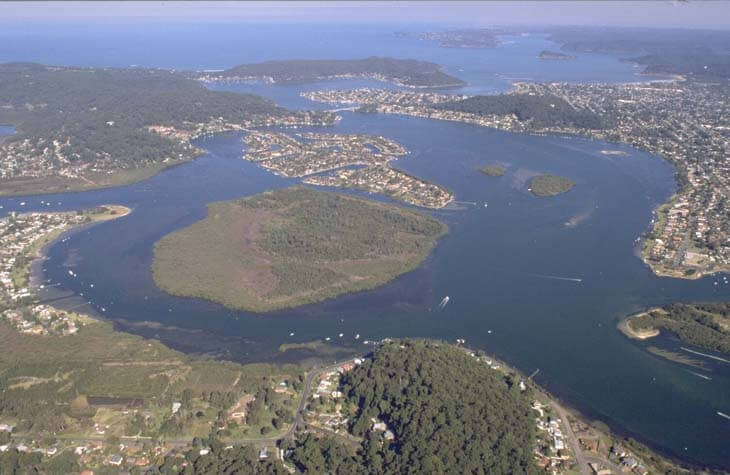Brisbane Water is situated on the Central Coast of New South Wales, north of Sydney. It is classed as a lake, and its untrained entrance at Broken Bay is permanently open to the ocean.
The estuary comprises a series of creeks, lakes, channels and islands that support a large range of biodiverse habitats. The estuary also has high recreational value because of its proximity to dense urban areas.
Water quality report card
As part of our water quality monitoring program we assess the water quality and ecosystem health of an estuary using a range of relevant indicators. We sample 3 sites and a number of inflowing streams on a monthly basis over summer in Brisbane Water as part of a collaborative program with Central Coast Council.
The most recent sampling was completed over the 2020–21 summer. The results of the monitoring program, including a detailed water quality report card for Brisbane Water, are available on the the Central Coast Council website.
This report card represents 2 water quality indicators that we routinely measure: the amount of algae present and water clarity. Low levels of these 2 indicators equate with good water quality.
Algae
Water clarity
Overall grade
The report card shows the condition of the estuary was good with:
- algae abundance graded fair (C)
- water clarity graded excellent (A)
- overall estuary health graded good (B).
Grades for algae, water clarity and overall are represented as:
- A – excellent
- B – good
- C – fair
- D – poor
- E – very poor.
Go to estuary report cards to find out what each grade means, read our sampling, data analysis and reporting protocols, and find out how we calculate these grades.
We have monitored water quality in Brisbane Water since 2010. This table shows the water quality grades for this estuary over that time.
| Year | Algae | Water clarity | Overall grade |
|---|---|---|---|
| 2010–11 | A | A | A |
| 2013–14 | A | A | A |
| 2016–17 | B | A | A |
| 2017–18 | A | A | A |
| 2018–19 | A | A | A |
| 2019–20 | C | A | B |
| 2020–21 | C | A | B |
As part of our Beachwatch program we assess swimming suitability at 4 swimming sites in Brisbane Water using microbial indicators. Central Coast Council collect samples at each site weekly between October and April, and monthly from May to September, to calculate the suitability grade. Sampling is ongoing. Each grade reflects the most recent 100 water quality results to April 2022. Find out more about how we monitor beach water quality at Beachwatch.
Central Coast local government area swimming sites
| Swim site name | Grade |
|---|---|
| Yattalunga Baths | Poor |
| Woy Woy Baths | Poor |
| Davistown Baths | Poor |
| Pretty Beach Baths | Poor |
Estuarine, lake and lagoon water can sometimes be unsuitable for swimming, especially after rainfall, when stormwater and wastewater can overflow into swimming areas. Learn more about what the grades mean and how we grade swimming sites on the Beachwatch How we report webpage. Water sampling and laboratory analysis were funded by Central Coast Council.
Physical characteristics
| Estuary type | Barrier river |
|---|---|
| Latitude | –30.38 (ºS) |
| Longitude | 153.1 (ºE) |
| Catchment area | 113.5 km2 |
| Estuary area | 1.7 km2 |
| Estuary volume | 1466.1 ML |
| Average depth | 1 m |
Tidal exchange volume
Tidal exchange volume or tidal prism data is available for this estuary. This tidal prism was measured in 1989.
| Tide state | Flow (ML) | Local tidal range (m) | Sydney Harbour tidal range (m) |
|---|---|---|---|
| Ebb flow | 25,800 | 1.26 | 1.36 |
| Flood flow | 21,300 | 1.42 | 1.49 |
Notes: km2 = square kilometres; m = metres; m3 = cubic metres; ML = megalitres.
Water depth and survey data
Bathymetric and coastal topography data for this estuary are available in our data portal.
Land use
The catchment of Brisbane Water is highly disturbed. Urban development is the dominant land use and occupies about 40% of the catchment. Substantial forested areas are protected in conservation areas to the east and west of the estuary. The major towns of Gosford and Woy Woy are located on the shores of Brisbane Water.
National and marine parks
- Brisbane Water National Park is the largest conservation area in this catchment.
- This estuary does not flow into a marine park.
Community involvement
- The Central Coast Council’s Landcare Program supports local volunteer groups to conserve, protect and remediate the different environments within the Brisbane Water catchment.

Aerial view of Brisbane Water.
Seafood harvest area status
The NSW Food Authority website lists the current status of oyster/shellfish harvest areas.
Local government management
Local councils manage estuaries within their area unless the estuary is attached to a marine park. Central Coast Council manages this estuary.
Information about this estuary can be found on the council’s Brisbane Water webpage.
Threatened species
This estuary supports habitat for many threatened plants and animals, including the bush stone-curlew.
Read more about the biodiversity in our estuaries.